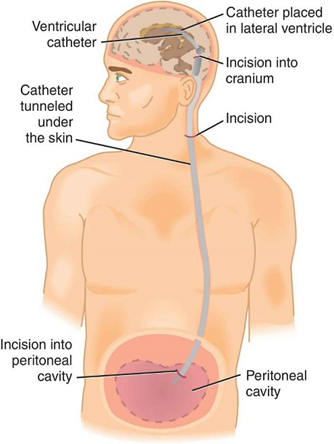A nurse is caring for a child who is postoperative following the insertion of a ventriculoperitoneal shunt. The nurse should place the child in which of the following positions?
A 45 degree head elevation
On the nonoperative side
Prone
Supine
The Correct Answer is D
A. A 45-degree head elevation: This position can help facilitate venous drainage and reduce intracranial pressure. Elevating the head of the bed may aid in preventing the accumulation of cerebrospinal fluid (CSF) in the brain, which is important after VP shunt insertion to maintain proper drainage. However, this position alone may not be sufficient.
B. On the nonoperative side: Placing the child on the nonoperative side can help reduce pressure on the side where the shunt was inserted, minimizing discomfort and the risk of disruption or displacement of the shunt. However, this position may not directly affect CSF drainage.
C. Prone: Placing the child prone (lying face down) is generally not recommended after VP shunt insertion. This position may increase pressure on the head and interfere with proper CSF drainage, potentially leading to complications.
D. Supine: Placing the child supine (lying on their back) is typically recommended after VP shunt insertion. This position helps promote proper drainage of CSF through the shunt system without placing undue pressure on the surgical site. It also allows for easy monitoring of the child's condition and surgical site.

Nursing Test Bank
Naxlex Comprehensive Predictor Exams
Related Questions
Correct Answer is B
Explanation
To calculate the appropriate dose of Theophylline for the child weighing 4.69 kg:
Dose = Weight (kg) × Dose (mg/kg)
Dose = 4.69 kg × 4 mg/kg
Dose = 18.76 mg
So, the appropriate dose is approximately 18.7 mg.
Correct Answer is C
Explanation
A. Measure the elixir in a medicine cup before transferring to a syringe:
This option involves measuring the medication using a medicine cup before transferring it to an oral medication syringe. While measuring the medication accurately is important, transferring it from a medicine cup to a syringe introduces an extra step that may increase the risk of spillage or dosage error. It's generally more efficient and accurate to directly draw the medication into the oral syringe.
B. Place the infant supine in a crib prior to administration:
Placing the infant in a supine (lying flat on the back) position in a crib prior to administering oral medication is not recommended, particularly for infants of this age. This position increases the risk of choking or aspiration, as it may cause the medication to flow toward the back of the throat rather than being swallowed properly. It's safer to administer oral medication to infants in an upright or slightly reclined position.
C. Position the syringe to the side of the infant's tongue:
This is the correct choice. Positioning the syringe to the side of the infant's tongue helps facilitate swallowing and reduces the risk of choking or aspiration. Placing the syringe toward the cheek allows the infant to more easily swallow the medication, as it minimizes the chance of the medication flowing toward the back of the throat.
D. Mix the medication with 10 mL of formula:
Mixing medication with formula is not a standard practice for administering oral medication using an oral syringe, particularly without specific instructions from the healthcare provider. Mixing medication with formula may alter the medication's effectiveness and is unnecessary for most oral medications. It's important to administer oral medication directly using an oral syringe to ensure accurate dosing and effectiveness.
Whether you are a student looking to ace your exams or a practicing nurse seeking to enhance your expertise , our nursing education contents will empower you with the confidence and competence to make a difference in the lives of patients and become a respected leader in the healthcare field.
Visit Naxlex, invest in your future and unlock endless possibilities with our unparalleled nursing education contents today
Report Wrong Answer on the Current Question
Do you disagree with the answer? If yes, what is your expected answer? Explain.
Kindly be descriptive with the issue you are facing.
